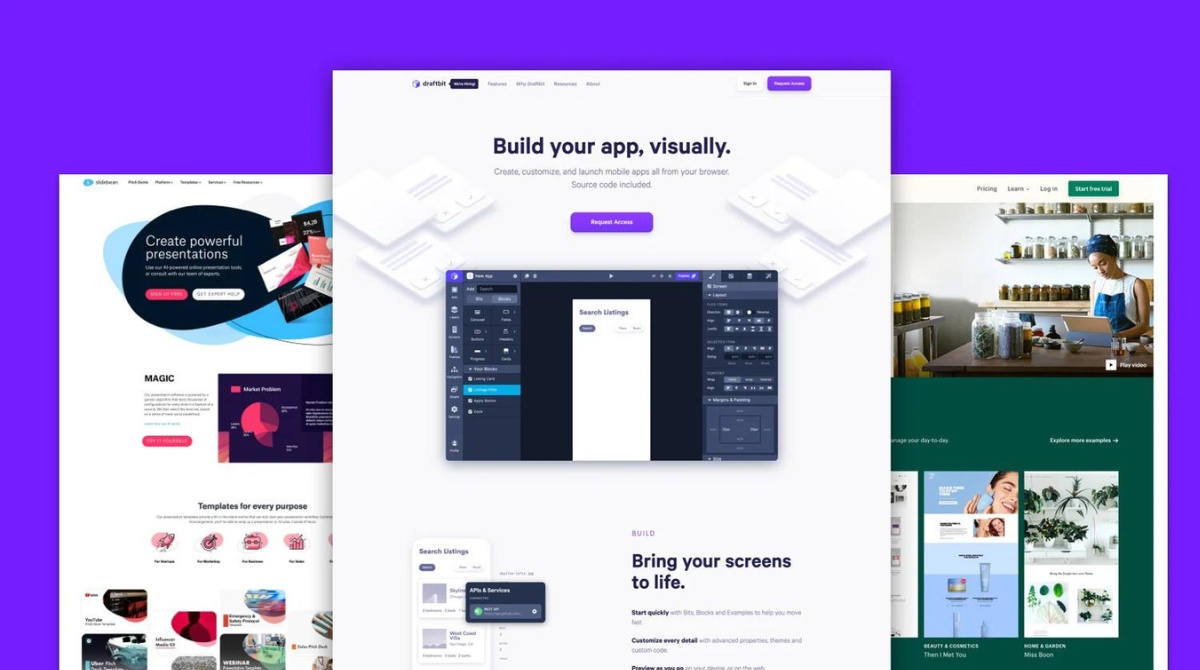Introduction
In today’s digital age, businesses are increasingly leveraging technology to streamline their operations and deliver services to customers in a more efficient and effective manner. One innovation that has gained significant popularity in recent years is the Software as a Service (SaaS) model. SaaS has revolutionized the software industry by offering a convenient and cost-effective way for businesses to access and use software applications.
SaaS refers to a software distribution model where applications are hosted by a third-party provider and made available to customers over the internet. Unlike traditional software, which requires installation on individual devices, SaaS applications are accessed through a web browser, providing users with the freedom to use the software from any device with an internet connection.
A crucial element of the SaaS model is the SaaS website, which serves as the primary interface between the software provider and the customers. It is through this website that users can sign up for the service, access the software, and manage their accounts.
A well-designed SaaS website is essential for attracting and retaining customers. It should effectively communicate the value proposition of the software, provide a seamless user experience, and offer easy navigation and intuitive functionality.
In this article, we will explore the key features of a SaaS website, the benefits it offers to businesses and users, and provide insights into designing and developing an effective SaaS website. Whether you are a software provider looking to establish your online presence or a business seeking a SaaS solution, this article will guide you through the essentials of a successful SaaS website.
Definition of SaaS
Software as a Service (SaaS) is a software delivery model that enables users to access and use applications over the internet on a subscription basis. Unlike traditional software, where users need to purchase and install the software on their own devices, SaaS allows users to use the software through a web browser without the need for installation.
With SaaS, the software application is hosted and maintained by a third-party provider, who handles the infrastructure, updates, and security. Users can simply log in to the application from any device with an internet connection, making it highly convenient and accessible.
One of the key advantages of the SaaS model is its subscription-based pricing structure. Instead of a one-time upfront cost, users pay a recurring fee for the software. This allows businesses to reduce their initial investment and only pay for the features and resources they need.
SaaS applications are typically accessed through a web browser, eliminating compatibility issues with different operating systems. This enables seamless access and collaboration, as users can work on the same application regardless of their location or device.
Another important aspect of SaaS is its scalability. As businesses grow and their software requirements increase, SaaS allows for easy scaling without the need for additional hardware or technical expertise. The provider can handle the increased demand and ensure a smooth experience for users.
Furthermore, SaaS providers are responsible for maintaining the software’s security and ensuring data protection. They implement robust security measures, such as encryption, access control, and regular backups, to safeguard user data from threats and breaches.
Overall, the SaaS model offers numerous benefits to both businesses and users. It provides cost savings, flexibility, scalability, and accessibility, making it an attractive choice for organizations of all sizes. By leveraging the power of the internet and cloud technology, SaaS has revolutionized the way software is delivered and consumed.
Understanding SaaS Websites
A SaaS website is the digital storefront and interaction platform for a software as a service (SaaS) provider. It serves as the primary means for users to learn about, sign up for, and access the SaaS application. A well-designed SaaS website is vital for establishing a strong online presence and attracting potential customers.
At its core, a SaaS website should effectively communicate the value proposition of the software to its target audience. It should clearly articulate the benefits and features of the application and how it can solve specific pain points or address specific needs. Through persuasive and informative copywriting, the website should convey the unique selling points of the software and convince visitors to take action.
In addition to communicating value, a SaaS website needs to provide a seamless user experience. It should have a clean and intuitive design, with easy navigation and clear call-to-action buttons. Users should be able to find the information they need quickly and easily, whether it’s pricing details, a demo, or customer testimonials. The website should also provide a smooth user onboarding process, allowing users to sign up for the service and start using the software in a hassle-free manner.
Furthermore, a SaaS website should showcase the credibility and trustworthiness of the software provider. This can be achieved through testimonials, case studies, and logos of well-known clients or partners. Security and privacy measures should also be prominently communicated to assure potential users that their data will be protected.
Since a SaaS website is a central hub for customer interactions, it is important to incorporate support and communication channels. This can include live chat, a knowledge base, or a contact form, allowing users to easily reach out for assistance or information. Providing prompt and helpful customer support can enhance user satisfaction and increase the chances of customer retention.
Lastly, it is crucial to continuously monitor and analyze the performance of a SaaS website. This can be done through tools like Google Analytics to track user behavior, conversion rates, and engagement metrics. By collecting and analyzing this data, SaaS providers can identify areas for improvement and make data-driven decisions to optimize the website’s performance and user experience.
In summary, a SaaS website is more than just an online brochure for a software solution. It is a powerful marketing and communication tool that plays a vital role in acquiring and retaining customers. By focusing on value communication, user experience, credibility, support, and performance analysis, SaaS providers can create a compelling and user-friendly website that drives conversions and growth.
Key Features of a SaaS Website
A SaaS website should be designed to effectively showcase the software’s features and benefits, engage visitors, and convert them into paying customers. To achieve this, there are several key features that are essential for a successful SaaS website:
- Clear and compelling value proposition: The website should clearly communicate the unique value that the software provides to its target audience. It should highlight the key features, functionalities, and advantages that set it apart from competitors.
- Intuitive user interface and navigation: The website should have a user-friendly design with a clean and intuitive layout. Navigation menus should be clear and easily accessible, allowing users to find information and access different sections of the website without confusion.
- Informative and persuasive content: The copywriting on the website should effectively communicate the benefits and value of the software. It should be concise, yet comprehensive, providing clear information about the features, pricing, and any other relevant details. The content should be persuasive, addressing the pain points of potential customers and showcasing how the software can solve their problems.
- Eye-catching visuals: The use of high-quality images, videos, and graphics can greatly enhance the visual appeal of the website. Visual elements can help to convey the software’s functionality, demonstrate its user interface, or simply make the website more attractive and engaging.
- Strong calls to action (CTAs): The website should have clear and prominent calls to action that guide users towards the desired actions, such as signing up for a trial or making a purchase. CTAs should be strategically placed throughout the website and use persuasive language to encourage conversions.
- Responsive design: With the increasing use of mobile devices, it is crucial for a SaaS website to have a responsive design that adapts to different screen sizes. This ensures that the website is accessible and provides a seamless user experience across all devices.
- Customer testimonials and social proof: Including testimonials from satisfied customers and showcasing positive reviews can help to build trust and credibility. Social proof helps potential customers feel more confident in their decision to choose the SaaS solution.
- Transparent pricing and plans: The website should clearly display the pricing and subscription plans, including any additional costs or limitations. Transparency in pricing helps to build trust and ensures that potential customers have all the information they need to make an informed decision.
- Easy access to customer support: Providing accessible and responsive customer support options, such as live chat or a support ticket system, can greatly enhance the user experience. It allows users to get prompt assistance when they have questions or encounter issues with the software.
By incorporating these key features into the design and functionality of a SaaS website, businesses can create a compelling and user-friendly experience that attracts and converts potential customers.
Benefits of a SaaS Website
A well-designed SaaS website offers numerous benefits to both the software provider and its customers. Let’s explore some of the key benefits below:
- Accessibility and convenience: A SaaS website allows users to access the software from anywhere with an internet connection. This level of accessibility and convenience eliminates the need for local installations and enables users to use the software on various devices, providing flexibility and convenience.
- Cost savings: With a SaaS website, users can access the software through a subscription model, eliminating the need for upfront costs associated with purchasing and installing traditional software. The pay-as-you-go pricing structure allows businesses to scale their usage and payment based on their needs, resulting in potential cost savings.
- Scalability and flexibility: SaaS websites allow for easy scalability as the software can handle growing user demands and increased data storage requirements. Updates and enhancements can be seamlessly deployed by the software provider, ensuring that users have access to the latest features and improvements without the need for manual updates.
- Continual software updates and maintenance: SaaS providers are responsible for keeping the software up-to-date, maintaining its performance, and ensuring the necessary security measures. This frees up businesses from the burden of managing software updates and allows them to focus on their core activities.
- Enhanced collaboration and communication: SaaS websites often include collaboration features, such as document sharing, real-time editing, and communication tools. These features enable teams to work together seamlessly, improving productivity and communication among team members.
- Improved security and data protection: SaaS providers prioritize the security and privacy of user data by implementing robust security measures, data encryption, and regular backups. This ensures the safety of sensitive information and reduces the risk of data loss or breaches compared to storing data locally.
- Reduced IT infrastructure and maintenance: With a SaaS website, businesses can eliminate the need for complex IT infrastructure and reduce the costs associated with hardware maintenance and updates. This allows businesses to focus on their core competencies instead of diverting resources to managing IT infrastructure.
- Improved customer support: SaaS websites typically include support channels such as live chat, knowledge bases, and customer forums. This enables users to easily access customer support and get prompt assistance when needed, enhancing the overall customer experience.
- Easy integration with other software: Many SaaS applications offer integrations with popular business tools, enabling seamless data exchange and workflow automation. This integration capability allows businesses to leverage their existing software stack and enhance overall productivity and efficiency.
These benefits make SaaS websites an attractive choice for businesses and individuals seeking software solutions. The accessibility, cost savings, scalability, and convenience offered by SaaS websites have transformed the software industry and revolutionized the way software is accessed and utilized.
Common Examples of SaaS Websites
SaaS websites have become increasingly prevalent in various industries, providing software solutions and services to businesses and individuals. Here are some common examples of SaaS websites across different sectors:
- Customer Relationship Management (CRM) Software: SaaS CRM platforms like Salesforce, HubSpot, and Zoho CRM offer businesses a centralized solution for managing customer relationships, sales pipelines, and marketing campaigns. These websites provide users with access to a wide range of features, including lead management, contact organization, sales tracking, and analytics.
- Project Management Tools: SaaS project management platforms like Asana, Trello, and Basecamp help teams collaborate, organize tasks, and manage projects efficiently. These websites offer features such as task assignment, progress tracking, file sharing, and communication tools, allowing teams to stay organized and work together seamlessly.
- Email Marketing Software: SaaS email marketing platforms such as Mailchimp, Constant Contact, and Sendinblue enable businesses to create, automate, and analyze email marketing campaigns. These websites offer features like customizable email templates, contact segmentation, automated workflows, and performance tracking, making email marketing campaigns more effective and efficient.
- Human Resources Management Systems (HRMS): SaaS HRMS platforms like BambooHR, Workday, and Zenefits provide businesses with a comprehensive solution for managing employee data, payroll, benefits, and performance reviews. These websites offer features such as employee self-service portals, time-off tracking, onboarding tools, and compliance management.
- Customer Support and Help Desk Software: SaaS customer support platforms like Zendesk, Freshdesk, and Intercom help businesses manage customer inquiries and provide efficient support. These websites offer features such as ticketing systems, live chat, knowledge bases, and feedback management, allowing businesses to deliver superior customer service.
- Accounting and Financial Management Software: SaaS accounting software such as QuickBooks, Xero, and FreshBooks simplify financial management tasks for businesses. These websites provide features like expense tracking, invoicing, financial reporting, and integration with banking systems, helping businesses streamline their financial operations.
- Collaboration Tools: SaaS collaboration platforms like Google Workspace, Microsoft 365, and Slack facilitate seamless communication and collaboration among team members. These websites offer features such as cloud storage, document collaboration, video conferencing, and team messaging, enhancing productivity and enabling remote work.
- Website Building and Content Management Systems (CMS): SaaS website builders and CMS platforms like WordPress.com, Wix, and Squarespace enable businesses and individuals to create and manage professional websites without coding knowledge. These websites offer intuitive interfaces, customizable templates, drag-and-drop editors, and hosting services, simplifying the process of website creation and management.
These are just a few examples of the diverse range of SaaS websites available today. From CRM and project management to email marketing and HRMS, the SaaS model has transformed various industries, offering businesses efficient and scalable solutions to meet their software needs.
SaaS Website vs Traditional Website
When it comes to delivering software solutions, two common approaches are SaaS websites and traditional websites. Let’s explore the differences between these two types:
SaaS Website: A SaaS website serves as the primary interface for accessing and using software applications. It follows a subscription-based model, where users access the software through a web browser without the need for local installations. Key characteristics of SaaS websites include:
- Accessibility: SaaS websites offer the flexibility to access the software from any device with an internet connection. This accessibility enables users to work remotely and collaborate effectively, as long as they have an internet connection.
- Scalability: SaaS websites are designed to scale effortlessly as users’ needs grow. The infrastructure and resources are managed by the software provider, allowing businesses to easily accommodate increased demands without the need for additional hardware or technical expertise.
- Updates and Maintenance: SaaS providers handle software updates and maintenance, ensuring that users always have access to the latest features and improvements. Users don’t need to worry about manual updates or managing servers, freeing up their time and resources.
- Subscription Pricing: SaaS websites typically operate on a subscription-based pricing model, where users pay a recurring fee to access the software. This approach allows businesses to reduce upfront costs and pay only for the features and resources they need, making it a cost-effective choice.
- Multi-tenancy: SaaS websites often leverage a multi-tenant architecture, where multiple customers share the same software instance while maintaining data isolation and security. This efficiency allows the software provider to serve a large user base without compromising performance or data privacy.
Traditional Website: A traditional website is typically used to showcase information, products, or services, rather than providing access to a specific software application. Key characteristics of traditional websites include:
- Uniqueness and Customization: Traditional websites offer a higher level of customization and uniqueness, allowing businesses to tailor their design and features to align with their branding and specific needs. This level of customization may require more technical expertise or the involvement of web developers.
- Data Control: With traditional websites, businesses have full control over their data and hosting environment. This allows for greater customization, security measures, and compliance with specific industry requirements. However, it also means that businesses are responsible for software updates, maintenance, and data backups.
- One-time Purchase: Traditional websites often rely on a one-time purchase model, where users buy the software or a license upfront. This can involve higher initial costs compared to SaaS websites but may offer more ownership and control over the software.
- Static or Dynamic Content: Traditional websites can have static or dynamic content. Static websites are made up of fixed HTML pages, while dynamic websites use server-side technologies to generate content on the fly. Dynamic websites can offer more interactivity and personalization capabilities.
- Website Hosting and Infrastructure: With traditional websites, businesses are responsible for hosting their website on servers. This includes selecting a hosting provider, managing hardware resources, and ensuring server stability.
While both SaaS websites and traditional websites have their advantages, the decision to choose one over the other depends on the specific requirements and goals of the business. SaaS websites offer accessibility, scalability, and cost savings, while traditional websites provide more customization and control. Ultimately, the choice will depend on factors like the nature of the software solution, budget, technical expertise, and desired level of control.
Considerations for Building a SaaS Website
Building a successful SaaS website requires careful planning and consideration. Here are some key factors to keep in mind when developing your SaaS website:
- Target Audience: Understand your target audience and their specific needs. Conduct thorough market research to identify their pain points, preferences, and expectations. This knowledge will inform the design, messaging, and functionality of your website.
- User Experience (UX): Prioritize user experience to ensure that your website is intuitive, easy to navigate, and visually appealing. Focus on simplicity and streamline the user journey to minimize friction and maximize conversions. Test your website’s usability through user testing and gather feedback for continuous improvement.
- Value Proposition: Clearly communicate the unique value your software offers. Highlight the key features, benefits, and use cases that differentiate your solution from competitors. Craft compelling messaging that resonates with your target audience and convinces them to choose your software.
- Responsive Design: Optimize your website for different devices and screen sizes. Ensure that your website is responsive, meaning it adapts and functions seamlessly on desktops, laptops, tablets, and mobile devices. Responsive design enhances user experience and improves search engine rankings.
- Conversion Strategy: Incorporate effective call-to-action buttons, lead capture forms, and persuasive copy to drive conversions. Clearly define the desired actions you want users to take on your website, such as signing up for a free trial or purchasing a subscription. Continuously monitor and test conversion rates to optimize performance.
- Security and Compliance: Prioritize the security and privacy of user data. Implement robust security measures, such as SSL certificates, encryption protocols, and access controls, to protect sensitive information. Comply with data protection regulations, such as GDPR or CCPA, to build trust with your users.
- Scalability and Performance: Design your website and infrastructure to handle growing user demands. Ensure that your website can handle increased traffic and usage without compromising performance or load times. Consider using content delivery networks (CDNs) and scalable hosting solutions to accommodate growth.
- Analytics and Tracking: Implement web analytics tools, such as Google Analytics, to gather insights on user behavior, website performance, and conversion metrics. Track key performance indicators (KPIs) to identify areas of improvement and make data-driven decisions to optimize your website.
- Customer Support: Provide accessible and responsive customer support options. Incorporate live chat, knowledge bases, FAQs, and a contact form to assist users when they have questions or encounter issues. Prioritize prompt and helpful support to enhance customer satisfaction and retention.
- Continuous Optimization: Regularly analyze website performance and user feedback to identify areas for improvement. Test variations of design elements, messaging, and calls to action to optimize conversions. Stay updated with industry trends and best practices to ensure your website remains competitive.
By considering these factors and incorporating them into the development process, you can create a compelling and user-friendly SaaS website that effectively engages and converts your target audience.
Tips for Designing and Developing a SaaS Website
Designing and developing a SaaS website requires careful planning and attention to detail. Here are some tips to help you create an effective and user-friendly SaaS website:
- Know your target audience: Understand the needs, preferences, and pain points of your target audience. This knowledge will guide your design decisions and help you tailor the website to meet their specific requirements.
- Create a clear and compelling value proposition: Clearly communicate the unique value your software offers. Explain how it solves specific problems or addresses specific needs. Use persuasive copy and visuals to capture visitors’ attention and convince them to explore further.
- Simplify the user journey: Streamline the user experience by creating a clear and intuitive navigation structure. Guide users through the website with clearly defined paths and guide them towards desired actions, such as signing up for a free trial or making a purchase.
- Optimize website performance: Ensure that your website loads quickly and performs well across different devices and internet connections. Compress images, minify code, and leverage caching techniques to improve page load times and provide a smooth user experience.
- Design for responsiveness: Prioritize a responsive design that adapts to various screen sizes and devices. Test your website on different devices to ensure that it displays and functions correctly on desktops, laptops, tablets, and smartphones.
- Use clear and persuasive calls to action (CTAs): Include prominent and visually appealing CTAs throughout your website. Use persuasive language to encourage visitors to take the desired actions, such as signing up for a trial or scheduling a demo.
- Highlight customer testimonials and social proof: Display testimonials, case studies, and reviews from satisfied customers to build trust and credibility. Showcase successful use cases and highlight the positive experiences of your existing customers.
- Optimize for search engines: Conduct keyword research and implement SEO strategies to improve your website’s visibility in search engine results. Optimize page titles, meta descriptions, and content to target relevant keywords and attract organic traffic.
- Prioritize data security and privacy: Implement robust security measures to protect user data. Use SSL certificates to ensure secure communication and encrypt sensitive information. Comply with data protection regulations to build trust with your users.
- Make customer support easily accessible: Provide various channels for users to contact your customer support team. Include a live chat feature, a help center, and a contact form to address user inquiries and assist them promptly.
- Continuously test and iterate: Regularly test and analyze your website’s performance, user behavior, and conversion rates. Collect user feedback and make data-driven decisions to optimize the design, content, and functionality of your SaaS website.
By following these tips, you can create a user-friendly and visually appealing SaaS website that effectively communicates your software’s value proposition, engages visitors, and converts them into happy customers.
Best Practices for Marketing a SaaS Website
Once you’ve designed and developed your SaaS website, it’s essential to implement effective marketing strategies to promote your software and attract potential customers. Here are some best practices for marketing a SaaS website:
- Define your target audience: Clearly define your target audience based on their demographics, interests, and pain points. Understanding your audience will help you tailor your marketing messages and channels to reach the right people.
- Create compelling and informative content: Develop valuable content that educates and engages your target audience. Publish blog posts, case studies, whitepapers, and videos that demonstrate your software’s capabilities and provide solutions to common industry challenges.
- Optimize your website for search engines: Implement on-page SEO techniques like keyword optimization, meta tags, and relevant content. Improve your website’s visibility in search engine results to attract organic traffic and potential customers.
- Utilize social media: Leverage social media platforms where your target audience is active. Share engaging content, interact with users, and participate in relevant conversations. Use social media advertising to reach a wider audience and promote your software.
- Implement email marketing: Build an email list by offering valuable content or incentives in exchange for email addresses. Use email marketing campaigns to nurture leads, promote new features, and engage with your user base.
- Establish thought leadership: Position yourself as an industry expert by participating in relevant forums, contributing to industry publications, and speaking at conferences or webinars. Share your knowledge and insights to build credibility and attract attention to your SaaS website.
- Offer free trials or demos: Provide potential customers with a hands-on experience of your software by offering free trials or product demos. This allows them to explore the features and benefits of your software and increases the likelihood of conversion.
- Develop strategic partnerships: Identify complementary businesses or influencers in your industry and establish partnerships. Collaborate on joint marketing initiatives, share resources, or co-host webinars to expand your reach and access new customer segments.
- Leverage customer testimonials and case studies: Highlight success stories and positive feedback from your existing customers. Share testimonials, case studies, or video testimonials on your website, social media channels, and marketing materials to build trust and credibility.
- Track and analyze marketing efforts: Utilize tools like Google Analytics and marketing automation platforms to track the performance of your marketing campaigns. Analyze key metrics, such as website traffic, conversions, and customer acquisition cost, to optimize your marketing strategies.
By following these best practices, you can effectively market your SaaS website, increase brand awareness, drive traffic, and generate leads. Remember to continuously evaluate and refine your marketing efforts based on the insights and data you gather to maximize your success.
Conclusion
Building and marketing a successful SaaS website requires careful consideration of various factors, from understanding your target audience to implementing effective marketing strategies. By following best practices and incorporating key features, you can create a user-friendly and visually appealing SaaS website that engages visitors, converts them into customers, and helps grow your business.
When designing a SaaS website, focus on clearly communicating your software’s value proposition, ensuring a seamless user experience, and optimizing for responsiveness across devices. Highlighting customer testimonials, providing easy access to customer support, and prioritizing data security are also crucial elements to gain trust and build credibility.
In the marketing phase, define your target audience, create compelling content, and optimize your website for search engine visibility. Leverage social media platforms, implement strategic email marketing, and establish thought leadership to reach and engage with potential customers. By offering free trials or demos and showcasing customer success stories, you can also encourage conversions and strengthen your brand reputation.
Continuously analyze and optimize your website’s performance, marketing efforts, and user feedback. Regularly test and iterate on design elements and messaging to improve conversion rates and user satisfaction.
Remember, the SaaS industry is dynamic and competitive, so staying up to date with industry trends and best practices is essential. Embrace innovation, adapt to changing customer needs, and be responsive to feedback to maintain a competitive edge.
By employing these strategies and continuously refining your approach, you can build a successful and impactful SaaS website that attracts, converts, and retains customers, ultimately driving the growth of your business in the software-as-a-service industry.

























